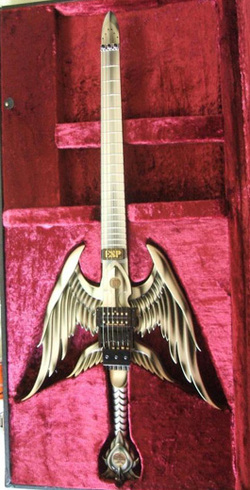Cast your mind, if you will, to a little piece of modern American history made famous by some fat documentarian in a cap:
Stirring, stirring stuff. But regardless of what side of the political picket fence you loiter, you just have to wander how much MORE effective his rallying cry would have been with some kind of pulsating beat backing it up.
A little something like this. (use as background music, the video is as dated as Heston's musket).
Only in America, then, the home of them kids' hippity hoppity music with the bippin' and the boppin' and malarkey and bein' up late, and the National Rifle Association, could form the incredible amalgamation that is the weaponised guitar.
Behold!
A little something like this. (use as background music, the video is as dated as Heston's musket).
Only in America, then, the home of them kids' hippity hoppity music with the bippin' and the boppin' and malarkey and bein' up late, and the National Rifle Association, could form the incredible amalgamation that is the weaponised guitar.
Behold!
My friends, colleagues and haters among you: this truly is awesome. A grotesque thing of beauty, an interrupted cadence of musico-political malaise, the no-scope shot on a stairway to heaven.
The interrupted cadence, FYI, is known in musical theory terms as a "5-6". Assuming you're in the key of C, it means linking a G-major chord to the a-minor (usually from tonic to second inversion) to create a jarring effect that demands the melody continue on to resolve itself.
Anthropologists speculate the Weaponised Guitar owes much to patriarchal developments in hunter gatherer societies. By emulating bird calls and staking territory through song, primitive males sculpted phallic instruments to best each other in the arena of mortal rock-offs.
Women, instead, prefered to play steel drums.
The interrupted cadence, FYI, is known in musical theory terms as a "5-6". Assuming you're in the key of C, it means linking a G-major chord to the a-minor (usually from tonic to second inversion) to create a jarring effect that demands the melody continue on to resolve itself.
Anthropologists speculate the Weaponised Guitar owes much to patriarchal developments in hunter gatherer societies. By emulating bird calls and staking territory through song, primitive males sculpted phallic instruments to best each other in the arena of mortal rock-offs.
Women, instead, prefered to play steel drums.

Thy riff be sheathed
As centuries progressed and jamfare developed from an agrarian recitatives to today's more post-modern, bullet-riddled angst, the instruments changed with technology.
Dating back to medieval times, musical swords developed a greater timbre and ability to hold a note through the forging of damascus steel, which coincidentally was also great for the lopping off of heads.
Several hundred years later, the discovery of gunpowder changed the face of the weaponised guitar forever. Musical notes could now be propelled at targets hundreds of yards away, with deadly accuracy.
The utility and usefulness of the foot-soldier, in short, was now over. Ambient virtuoso performances were now all the rage, while plonking along at muddled low frequencies became obsolete.
Virtuoso tunes quickly encompassed the value of individual performance and with it came the weaponised guitar solo, the most exalted of which involved extreme physical endurance, masterful improvisation, death and destruction, and a new high score.
Because of police clampdowns on such things, underground subcultures exist to this day where the weaponised guitar is lauded for its musical carnage and long-distance kill counts.
Dating back to medieval times, musical swords developed a greater timbre and ability to hold a note through the forging of damascus steel, which coincidentally was also great for the lopping off of heads.
Several hundred years later, the discovery of gunpowder changed the face of the weaponised guitar forever. Musical notes could now be propelled at targets hundreds of yards away, with deadly accuracy.
The utility and usefulness of the foot-soldier, in short, was now over. Ambient virtuoso performances were now all the rage, while plonking along at muddled low frequencies became obsolete.
Virtuoso tunes quickly encompassed the value of individual performance and with it came the weaponised guitar solo, the most exalted of which involved extreme physical endurance, masterful improvisation, death and destruction, and a new high score.
Because of police clampdowns on such things, underground subcultures exist to this day where the weaponised guitar is lauded for its musical carnage and long-distance kill counts.
With the renaissance period came global trade and musical colonisation of the unknown world. Imperialist musicians made their way to Africa, who blindly taught euro and amero-centric melodies to the Dark Continent's masses.
Hamfisted borders were drawn like a child with a ruler, as Sudan's Drum 'n Bass became fatefully crossed with Ethiopian House, while Nigerian classic rock jarred heavily with the Central African Republic's punk rock generation.
Despite all the best of intentions, rock and roll was now a tool for bloodshed.
Hamfisted borders were drawn like a child with a ruler, as Sudan's Drum 'n Bass became fatefully crossed with Ethiopian House, while Nigerian classic rock jarred heavily with the Central African Republic's punk rock generation.
Despite all the best of intentions, rock and roll was now a tool for bloodshed.
Don't worry, though. Apparently some cool UN dude showed up and all was well. Now all them Africans gotta do is open their borders to Walmart and eat US-patented GM crops. What am I, an expert?
As with all things post-modern, the spiraling technological development meant society had come so far, it had to go backwards. Futurist thinkers speculate the future of the weaponised guitar indeed lies in its primordial past.
Combining the greatest of electric sounds, brutal power and reproductive joy, the weaponised guitar now truly puts the 'gun' in '21 gun salute'.
As with all things post-modern, the spiraling technological development meant society had come so far, it had to go backwards. Futurist thinkers speculate the future of the weaponised guitar indeed lies in its primordial past.
Combining the greatest of electric sounds, brutal power and reproductive joy, the weaponised guitar now truly puts the 'gun' in '21 gun salute'.



 RSS Feed
RSS Feed
